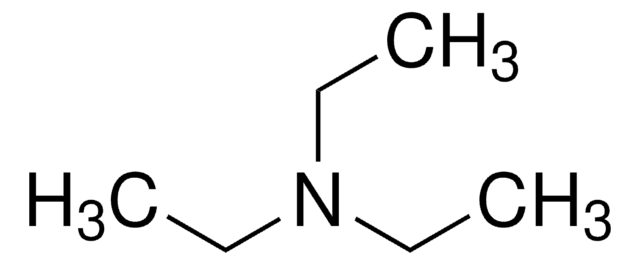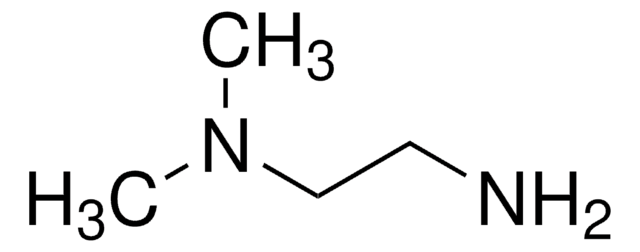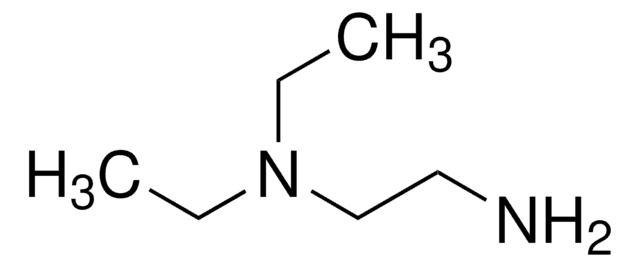156930
Lauroyl chloride
98%
Synonym(s):
Dodecanoyl chloride
Sign Into View Organizational & Contract Pricing
All Photos(1)
About This Item
Linear Formula:
CH3(CH2)10COCl
CAS Number:
Molecular Weight:
218.76
Beilstein:
1281201
EC Number:
MDL number:
UNSPSC Code:
12352100
PubChem Substance ID:
NACRES:
NA.22
Recommended Products
Quality Level
Assay
98%
form
liquid
refractive index
n20/D 1.445 (lit.)
bp
134-137 °C/11 mmHg (lit.)
solubility
methanol: soluble 100 mg/mL, clear
density
0.946 g/mL at 25 °C (lit.)
functional group
acyl chloride
SMILES string
CCCCCCCCCCCC(Cl)=O
InChI
1S/C12H23ClO/c1-2-3-4-5-6-7-8-9-10-11-12(13)14/h2-11H2,1H3
InChI key
NQGIJDNPUZEBRU-UHFFFAOYSA-N
Application
Lauroyl chloride was used:
- as tailoring agent for chemical modification of nanocelluloses of different length, nanofibrillated cellulose and cellulose nanocrystals
- in the preparation of acylated collagen with water solubility and better surface activity
- as organic low-friction boundary lubricant in the preparation of novel polyvinyl alcohol hydrogel
- in the synthesis of hemicellulose-based hydrophobic biomaterials
Signal Word
Danger
Hazard Statements
Precautionary Statements
Hazard Classifications
Skin Corr. 1B
Storage Class Code
8A - Combustible corrosive hazardous materials
WGK
WGK 3
Flash Point(F)
284.0 °F - closed cup
Flash Point(C)
140 °C - closed cup
Personal Protective Equipment
dust mask type N95 (US), Eyeshields, Gloves
Regulatory Information
危险化学品
Choose from one of the most recent versions:
Already Own This Product?
Find documentation for the products that you have recently purchased in the Document Library.
Parvaiz Ahmad Bhat et al.
Food chemistry, 340, 128168-128168 (2020-10-05)
The chemical instability of Citral in acidic conditions is viewed as hurdle to commercialize it in food/beverage industries. We attempted to stabilize citral in various single and mixed surfactant systems at pH 1.0 and temperature 25 °C. The study highlights the
Michelle M Blum et al.
Journal of biomedical materials research. Part B, Applied biomaterials, 100(7), 1755-1763 (2012-07-19)
A novel material design was developed by functionalizing polyvinyl alcohol hydrogel with an organic low-friction boundary lubricant (molar ratios of 0.2, 0.5, and 1.0 moles of lauroyl chloride). The hydrogels were fabricated using two different techniques. First, the boundary lubricant
Conghu Li et al.
International journal of biological macromolecules, 57, 92-98 (2013-03-19)
A new kind of acylated collagen with water solubility and better surface activity was prepared via reaction of pepsin-solubilized calf skin collagen with lauroyl chloride and succinic anhydride in this paper. The equilibrium surface tension and the isoelectric point were
Ana G Cunha et al.
Langmuir : the ACS journal of surfaces and colloids, 30(31), 9327-9335 (2014-07-22)
Nanocelluloses are bio-based nanoparticles of interest as stabilizers for oil-in-water (o/w) Pickering emulsions. In this work, the surface chemistry of nanocelluloses of different length, nanofibrillated cellulose (NFC, long) and cellulose nanocrystals (CNC, short), was successfully tailored by chemical modification with
Feng Peng et al.
Carbohydrate research, 343(17), 2956-2962 (2008-09-17)
Hemicellulose-based hydrophobic biomaterials with degrees of substitution ranging from 0.46 to 1.54 were synthesized under mild conditions in homogeneous media (N,N-dimethylformamide-lithium chloride) by reacting the native wheat straw hemicellulosic polymers with lauroyl chloride using 4-dimethylaminopyridine as a catalyst. Other catalysts
Our team of scientists has experience in all areas of research including Life Science, Material Science, Chemical Synthesis, Chromatography, Analytical and many others.
Contact Technical Service









